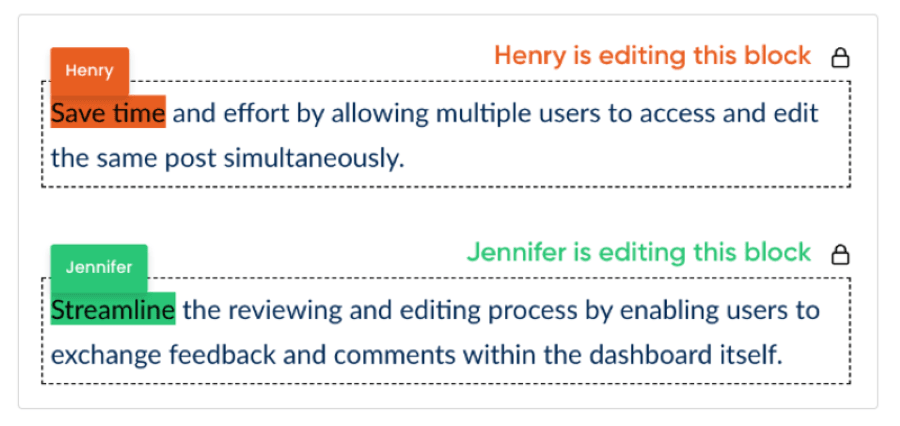For significant publications and enterprises, writing content, including images, on a Google Doc and then transferring it onto WordPress is a big pain point. Since these media companies need to publish news instantly and accurately, they need an everyday digital workplace where multiple members can collaborate and finalize the content.
This is why Multicollab is the solution to their business needs.
This is the review, where users will learn in detail what this tool is, why they should opt for it, what unique features it holds, and what separates it from Google Docs. Let’s dive right into it:
What is Multicollab
Multicollab is a comprehensive document editing tool that utilizes the same Google Doc simplicity but with additional cool perks. Designed specifically for WordPress, large news publishers and media agencies, such as Smart Asset, LABS, Politico, etc., prefer Muticollab because Google Doc does not sync with any CMS platform.
Multicollab stands apart from other online document editing tools with its unique features that focus on streamlining workflows. Apart from other features, Multicollab’s most prominent one is the Email and Slack notification action, which notifies users about any changes to the document.
How it works
The document owner can collaborate on the Mullticollab document when you prepare the initial draft. Afterward, you can invite multiple users and assign specific roles to each individual, such as a Viewer, co-editor, or commentator.
Here are some great features users can utilize within Multicollab:
Features
In-line comments
In this feature, you can mention a comment on the text portion or complete a paragraph. The editor will review the comment and select resolve in the comment option if the comment is addressed. You can also comment on an in-line picture or video.
One great option is that you can also attach a picture with your text comment to specify more clearly what change you want your editor to make.

Suggestion mode
The suggestion mode is handy for users who need to track detailed modifications to the document. This feature is turned off by default, so you must enable it from Settings. It works similarly to the “Suggesting” mode that we have in Google Docs.
One way to use it is to suggest formatting is when you suggest a text to make it bold, underline, or italicize, a dialogue box appears on the right side noting your suggestion. The editors will make suggestions on the document. It will appear if they accept the suggestion in the dialogue box, and the suggestions will be applied to the text.
You can suggest adding or deleting any text. In this case, the commented text will appear in red to the editor, and the suggested text will be displayed ahead of it. When the editor accepts the proposed text, the dialogue box will disappear along with the old text.

Guest collaboration
You can use this feature to designate specific roles for members to work on the document. The Guest Collaboration feature includes a Viewer and Commentor mode.
In the Viewer mode, users can only see the document, while the Commentor mode allows users to make comments and suggestions. Thus, the content is accessible only to authorized users.

Real-time editing
This is the most potent Multicollab’s tool. This option allows multiple teammates to collaborate simultaneously on a single document. Large publishers and enterprises use this feature to assign different content sections to writers/editors to speed up the content finalizing process and publishing.
All the work done by collaborators on real-time editing is recorded in an organized manner and can be reviewed anytime, re-modified, or commented on.

This feature is ideal for large content teams like Journalists, media reporters, and content creators who wish to collaborate on a single piece of content and frequently push updates as things happen.
Reports and Activity
The comprehensive Reports and activity feature is divided into three categories. The Dashboard option displays edits made by multiple users on each blog post in chronological order, starting from the latest to the oldest comments.
The report feature displays the data in a blog-wise manner, showing the number of blogs, contributors, total comments, open comments, and resolved comments to date.

Custom Permissions
With Custom Permission, you can assign roles to each member in more depth. For example, you can assign whether the user can only add comments, suggest edits, do real-time editing, or access all these options.

Multilingual
The Multicollab is available in multiple languages, such as Chinese, German, Spanish, Hindi, Bengali, and French, so members from different languages can use the tool.
Pricing
The Multicollab is priced starting from the Lite plan, which is $599/year, and ending at the Pro plan, which is $1499/year. There is an Enterprise plan, which starts from $5,000/year but varies based on the business type and complexity.
Users request a demo and talk with sales representatives first before buying the plan.
No Coupon Req.
What makes Multicollab different from Google Docs
Google Docs is undoubtedly an excellent tool for content writers. However, when it comes to serious content editing and publishing on a content management system (CMS), it needs several must-have features, which is why Multicollab is the best alternative. Here’s why.
It is specifically designed for WordPress, while Google Docs is a standalone document editing tool. It notifies any document changes on Slack, while Google Docs only informs via Email. Due to its robust content security feature, seamless collaboration, and numerous editing options, large publishers and media agencies prefer using it over Google Docs.
The takeaway
With Multicollab, significant publications and agencies produce high-quality content extremely fast. You can also use this tool in WordPress to deliver large and complex content in a concise amount of time. With its numerous features, you can ensure whoever stays on the document only accesses it up to the extent you permit.
